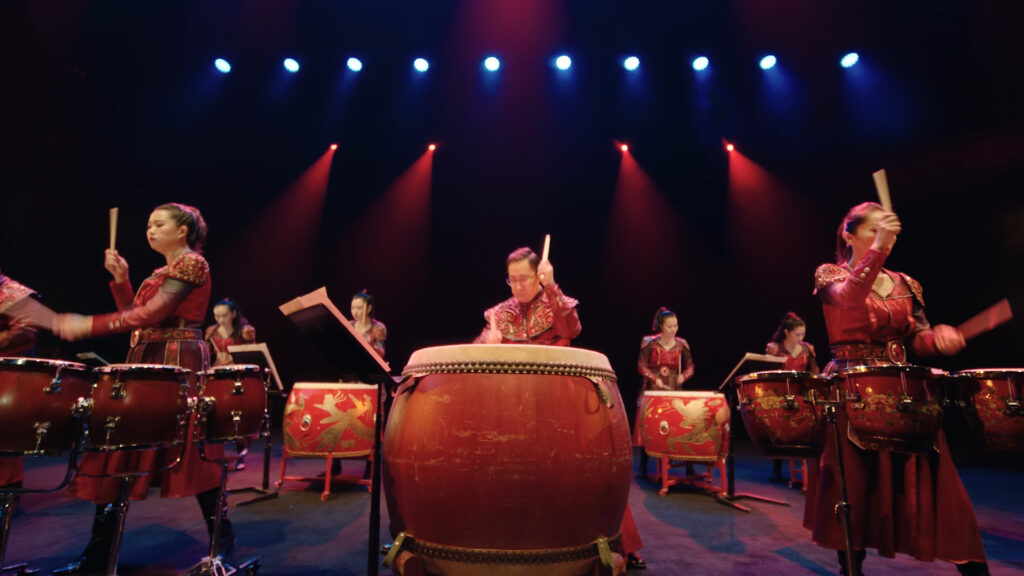
浙里有乐
浙里 有望得见的青山
浙里 有缠绵不绝的绿水
浙里 有忘不了的乡愁
浙里 有魂牵梦绕的乐音
There are lush mountains surrounding Zhejiang
There are lucid waters winding through Zhejiang
There is forever nostalgia for Zhejiang
There is lingering music in Zhejiang
“诗书礼乐”为中国古代儒家必修经典。民乐作为中华民族传统器乐演奏,亦有“国乐”之雅称。而江南丝竹,是这一方水土土里生水里长的音乐。乐音袅袅,根植于每一个江南人心中。诗画浙江离不开诗歌、美景、丝竹悦耳。后疫情时代,特推出线上民乐电影展演,以民乐的方式介绍浙江“四条诗路”之美景,串联浙江文化精华之“链”,串联浙江诗画山水之“链”,串联浙江全域文旅发展之“链”,从而展现“浙江之窗”的世界风貌。让世界听见浙江,感受中国。
Poetry, calligraphy, rituals and music are the classics of Confucianism in ancient China. Folk music, as a traditional instrumental music performance, is known as the national music. Among a myriad of genres of Chinese folk music, Jiangnan stringed and wind music is born and grown in the south Yangtze River region, and takes root in the heart of local people.
Zhejiang Province is a delightful image of poetry, scenery, and music. The online folk music film series are launched against the backdrop of the pandemic, displaying the beauty of Four Poetic Roads in the Province, and relating to Zhejiang’s cultural essence, picturesque landscape, and the development of cultural tourism, to bring the international-looking province and the world closer.
鼓 Drum

鼓文化与中华文明相伴而生数千年,先贤孔子曾说过“鼓之舞之”,可见“鼓舞”一词起源之早。中国鼓,最早以陶土烧制的“土鼓”,始现于陶器时代。从周朝起,鼓就已经规范地用于古代中国祭祀、军事、劳作及其他活动中。如今的中国鼓,已然有数十个品种(如安塞腰鼓、凤阳花鼓、手鼓等)。鼓文化的繁荣,反映的是中国社会的安定繁荣。鼓乐《钱王射潮》以多人大鼓演奏,鼓乐齐鸣盛世景,展现钱江潮涌与当代浙江儿女勇立潮头的时代风貌。
Drum culture dates to thousands of years ago, as evidenced by the sage Confucius’s quotes-“let’s get excited with the drumbeats”. Clay drum, the first Chinese drums was made in the Pottery Age. Drums have been widely used on ritual, military, and working occasions since the Zhou Dynasty. Nowadays there are dozens of types of Chinese drums, namely, Ansai waist drum, Fengyang flower drum, and the hand drum, etc. The rise of drum culture is the reflection of a stable and prosperous society. The drum music King Qian Shoots the Tide is played in unison and celebrates the Qianjiang River tide and the braveness of the contemporary Zhejiang people.
江神河伯两醯鸡,海若东来气吐霓。
安得夫差水犀手,三千强弩射潮低。
——苏轼【北宋】《八月十五日看潮五绝》
“Waves stirred by gods of the river are just tiny, compared with the roaring sea tide flowing from the east coast.
If armed soldiers of King Wu can be found, the tide is to be defeated when shot at by thousands of powerful crossbows.”
Watching the Tide on August 15th by Su Shi (Northern Song Dynasty)
鼓乐《钱王射潮》
Drum music: King Qian Shoots the Tide
作曲:徐可
演奏:王富生、皇甫庆玲、王轶炜等
Composed by: Xu Ke
Instruments:Wang Fusheng, HuangFu Qingling, Wang Yiwei, etc.
古琴 Guqin (A Chinese Seven-stringed Plucked instrument)

2003年,中国古琴艺术被联合国教科文组织列入“人类口头与非物质文化遗产”名录。作为中国古琴艺术的重要分支——浙派古琴于2008年被国务院列为第一批国家级非物质文化遗产名录扩展项目。由郭楚望所创立的浙派古琴在南宋独领风骚,独特的琴曲艺术一直影响到元、明各代。在浙江音乐河床里产生的浙派古琴也是我国第一个系统古琴流派,其质而不野,文而不史,潇洒自如,音韵流畅。崇尚“微、妙、圆、通”,追求典雅、平和、稳健、怡淡的意境。乐曲《竹林七贤》中,古琴与二胡、琵琶、笛箫等乐器的不断碰撞,彰显出了东方文化的风采。
In 2003, the Chinese Guqin entered the UNESCO Oral and Intangible Heritage of Humanity list. An important branch of the Chinese Guqin art, Zhejiang Guqin was among the list of the first batch of National Intangible Heritage issued by the State Council in 2008. Zhejiang Guqin was founded by Guo Chuwang and became the leading instrument in the Southern Song Dynasty, exerting great influence all the way to the Yuan and Ming dynasties. As the first systematic school of Guqin in China, Zhejiang Guqin features plainness, elegance, and fluency, upholds subtlety, smoothness, and fluency, and aims to create an elegant, calm, stable and light atmosphere. In the piece Seven Sages in the Bamboo Grove, Guqin, Erhu, Pipa, flute, and Xiao blends seamlessly and highlights oriental culture.
竹林笑傲今陈迹,抚榇江皋涕泫然。
——沈约【南朝】《复挽于湖居士》
“The respectable seven sages have become a distant legend.
I can’t help shedding tears of mourning.”
Tribute to Yuhu Jushi by Shen Yue (Southern Dynasty)
古琴《竹林七贤》
Gu qin performance: Seven Sages in the Bamboo Grove
作曲:王云飞
演奏:曹宇、刘燕、曲睿等
Composed by: Wang Yunfei
Instruments: Cao Yu, Liu Yan, Qu Rui, etc.
唢呐 Suona (A Chinese Double-reed Woodwind Instrument)

公元3世纪,唢呐由波斯、阿拉伯一带传入中国。在中国历经千百年岁月更迭,演奏技法的加工提升,如今已是中国民族吹管乐器的一种,也是中国各地广泛流传的民间乐器。该曲唢呐与民族乐队的演绎将民族风韵、现代技巧和时代气派的有机结合, 为一向以粗犷奔放著称的唢呐开辟了细腻婉约的新艺术风格。犹如山呼海应,时而风吹过山,掠过了海,时而听到海螺的低语,充分彰显唢呐演奏者的才华,令人耳目一新,难以忘怀。
The Suona was introduced to China from Persia and Arabia in the 3rd century AD. It has become both a representative of national music and a popular folk musical instrument over thousands of years in China. This Suona and folk band performance is an organic combination of folk charm, modern technique, and contemporary pulse, inventing a delicate artistic style of Suona other than just roughness. Imagine a gust of wind, sometimes sweeps across mountains and seas, and whispers to the conch at other times. It is a refreshing and unforgettable performance that fully demonstrates the talent of the Suona player.
海客谈瀛洲,烟涛微茫信难求;
越人语天姥,云霞明灭或可睹。
天姥连天向天横,势拔五岳掩赤城。
天台四万八千丈,对此欲倒东南倾。
我欲因之梦吴越,一夜飞度镜湖月。
湖月照我影,送我至剡溪。
谢公宿处今尚在,渌水荡漾清猿啼。
脚著谢公屐,身登青云梯。
半壁见海日,空中闻天鸡。
……
——李白【唐】《梦游天姥吟留别》
“While Yingzhou is a place hard to find,
Tian Mu Mountain is visible when clouds clear away.
The 48,000-feet-tall Tiantai Mountain is dwarfed by Tian Mu,
So are other mountains in the country.
I dreamed of a trip to Wu Yue, flying over to the Mirror Lake overnight, then to Shanxi.
The residence of Xie Gong is still there, full of vigor.
I climbed the cloud ladder, wearing Xie Gong’s clogs,
then I saw the sunrise above the sea and heard the rooster crowing in the sky.”
……
Dreaming of A Trip to Tian Mu Mountain by Li Bai (Tang Dynasty)
嵊州吹打《海唤天》
Shengzhou wind and drum music: Dream about the Sea and the Heaven
唢呐演奏:宋广顺 指挥:陈瑱璇
Composed by Xu Ke
Suona: Song Guangshun
Conductor: Chen Zhenxuan
古筝 Guzheng (A Chinese Plucked Zither)

古筝是一件伴随中国悠久文化,土生土长的古老民族乐器。它也被誉为“仁智之器”,承载传递着古老的民族文化精神。随着古筝艺术的发展,中华民族文化和音乐之间发生着千丝万缕的联系,华夏文明融入蕴含到古典音韵的古筝中,显示出古筝音乐的诗、情、意、韵。浙江筝明朗、细腻、绮丽、优雅,保留了江南丝竹音乐早期的形态,具有鲜明的江南水乡气息,常常反映出人民爱自然、爱家乡、爱生活的思想感情,表达着人们乐观向上的精神和追求美好理想的愿望。
古筝《清河水歌》表现荷似人,筝似水,人在舞,水在歌的江南婉约美的画卷。
Guzheng, an indigenous national instrument of long history, is also known as the instrument of benevolence and wisdom and a carrier of the ancient Chinese culture. As the Guzheng art develops, the Chinese culture and music are inextricably interconnected, adding poetry, emotion, meaning and rhythm to Guzheng music.Zhejiang Zheng features brightness, delicacy, and elegance. It retains the early form of Jiangnan music, creates a distinctive atmosphere of Jiangnan water town, reflects love for nature, hometown, and life, and expresses an optimistic spirit and a desire to pursue good ideals.
The Guzheng piece Qinghe Water Song depicts a picture of Jiangnan (areas south of the Yangtze River), in which the lotus flowers are dancing, and the sound of Zheng is rippling.
荷花开后西湖好,载酒来时。
不用旌旗,前后红幢绿盖随。
画船撑入花深处,香泛金卮。
烟雨微微,一片笙歌醉里归。
——欧阳修【北宋】《采桑子·荷花开后西湖好》
“The West Lake is most wonderful with the lotus in full blossom.
I wander to the lakeside, carrying drinks.
No need to raise flags, look, red banners and green covers follow me.
The boat sails deep into the waters where fragrant flowers grow.
Misty rain falls and we sing to our content on the return trip.”
Caisangzi – The West Lake with Lotus in Full Blossoms by Ouyang Xiu (Northern Song Dynasty)
古筝《清河水歌》
Guzheng: Qinghe River Song
作曲:邬娜
演奏:谢涛、段妍頔、李婷等
Composed by :Wu Na
Instruments:Xie Tao, Duan Yandi, Li Ting, etc.
感谢 Thanks
出品:浙江演艺集团有限责任公司
执行:浙江歌舞剧院有限公司
浙江民族乐团
Produced by: Zhejiang Performing Arts Group Co.
Presented by: Zhejiang Song and Dance Theatre Co.
Zhejiang Folk Music Orchestra
Facebook: China Cultural Center in Stockholm
https://www.facebook.com/China-Cultural-Center-in-Stockholm-110983273921638
Instagram: chinaculturalcenterinstockholm
https://www.instagram.com/chinaculturalcenterinstockholm/
Youtube: China Cultural Center in Stockholm
https://www.youtube.com/channel/UCYqOYwuQtyTHC-iMNdfExsw
Tik Tok: cccinstockholm
@cccinstockholm
地址/Address:
Västra Trädgårdsgatan 2, Stockholm
